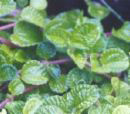Anise (Seed or Star): This aromatic spice brings to mind the wonderful smell of biscochitos baking in the oven. Anise is an important addition in many recipes for baked goods, but its remedial value should not be ignored. A wonderful tasting tea is made of the seeds for babies suffering from an upset stomach or restlessness. When a lactating mother drinks the same tea, it will contribute to increasing the value and flow of her milk supply.
 |
Basil: Basil is the Greek name for "king" which explains why this herb can be used in almost everything. The dried sweet leaves have a strong scent, and the minty flavor is especially popular in tomato-based dishes and pesto. |
Cilantro: This herb has a deliciously, strong aroma that faintly resembles anise. These flakes will add beauty and flavor to your soups, stews, fish, poultry, sauces, and salads.
Garlic (Allium Sativum):Garlic mildly displays a host of benefits: it is antibacterial, antifungal, antiviral, hypotensive (lowers high blood pressure), and lowers cholesterol and fat in the bloodstream. Garlic is used in Europe as an approved remedy for cardiovascular conditions, especially high cholesterol and triglyceride levels associated with risk of atherosclerosis. It is also generally regarded as a preventive measure for colds, flu and other infectious diseases.
 |
Oregano: Oregano is stronger, sharper, and slightly more bitter than marjoram. The Mexican version is stronger and sometimes mintier than the Mediterranean version and is popular in many Mexican dishes, such as chili con carne. Try adding to sauces and soups for a richer flavor. |
Parsley: Parsley adds a fresh flavor to many dishes, and it is rich with many vitamins and minerals. Add these flakes to sauces, salads, cheesy dishes, and potatoes.
Pitajaya (Pitaya) The cactus in New Mexico has violently red flowers and grows only from 12 to 18 inches in height. The Spanish New Mexicans gather these blossoms and boil them in half a cup of water as a remedy against swelling and dropsy. The decoction should be taken three times a day to dissipate the affliction. The cactus resembles the biznaga or Turk's Head, but smaller and grows close to the ground, it yields in the early days of Summer with a fruit the size of a small plum, green in color, filled with fine black seeds and the skin is quite thin. It rivals the strawberry or the raspberry indelicacy of flavor and in the graciousness with which it submits to every mode of treatment. It seems to be equally good whether served raw, stewed in pies and puddings or in ice cream, it makes an acceptable addition to juleps and lemonades.
 |
Rosemary: Rosemary's strong but pleasant flavor mixes with many meats and strong vegetables very well. Sprinkle on top of pizza or mix with olive oil and garlic for lamb, poultry, and veal dishes. |
Salvia (Sage): The well-known Salvia is an excellent aid in dry fevers and to dry up the milk supply in lactatin mothers. A tea of the herb is an excellent aid for digestion and will work effectively as a vermifuge to expel worms in children. A gargle of the plant is used whenever a sore, dry throat is present. Commonly referred to as "Sage". Salvia (along with lemon and chopped onion) is an excellent addition to posole.
 |
Yerba Buena (Spearmint): This universal mint is very popular among New Mexicans. The leaves of the plant are chewed as a breath freshener or added to iced teas and other beverages, taking advantage of their great taste. Besides being a tasty treat, Yerba Buena is an excellent aid in digestive disorders, low grade fevers, colic, and constipation. Traditionally, the herb is administered to pregnant women before, during, and after childbirth to act as a cleanser and to promote healing. Because the herb is a gentle calmative, its use for children is recommended. |
https://www.ladyoftheearth.com/herbs/definition-number-types.txt